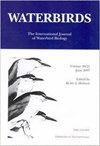Tracking Migration of Eastern Spot-Billed Ducks Anas zonorhyncha and Mallards Anas platyrhynchos Wintering in Shanghai, China
IF 0.6
4区 生物学
Q3 ORNITHOLOGY
引用次数: 1
Abstract
Millions of migratory waterfowl winter in the coastal wetlands in Shanghai City, among which Eastern Spot-billed Ducks and Mallards are among the most common species and are sensitive to infection with avian influenza virus. However, information on the migration behaviors of these two species in Northeast Asia is lacking. Therefore, GPS transmitters were used to track the migration of 13 Eastern Spot-billed Ducks and eight Mallards wintering in Shanghai during 2017–2020. Mallards covered a (mean ± standard deviation) migration distance of 1,663.69 ± 1,063.33 km, with wider variation than Eastern Spot-billed Ducks (1,639.24 ± 642.72 km), though the difference was not significant. Both species ended their northward migrations in Northeast Asia encircling the Yellow Sea, mainly in northeastern China. The dynamic Brownian bridge movement model confirmed that multiple stopover sites mainly located in the Korean Peninsula along the Yellow Sea coastline were crucial nodes for maintaining the stability and function of the migration network. This study confirmed the close relationships between habitats in the Korean Peninsula and China, indicating the importance of habitat conservation in related countries to the stability of the migration network. The results of this study additionally highlight the relationships between migration behaviors and outbreaks of avian influenza virus in Northeast Asia.上海东部斑嘴鸭和绿头鸭越冬的迁徙追踪
数以百万计的迁徙水禽在上海沿海湿地越冬,其中东部斑嘴鸭和绿头鸭是最常见的物种,对禽流感病毒感染敏感。然而,关于这两个物种在东北亚的迁徙行为的信息缺乏。为此,利用GPS发射机对2017-2020年在上海越冬的13只东部斑嘴鸭和8只绿头鸭的迁徙进行了跟踪。绿头鸭的迁徙距离(平均±标准差)为1663.69±1063.33 km,差异大于东部斑嘴鸭(1639.24±642.72 km),但差异不显著。这两个物种都在围绕黄海的东北亚,主要在中国东北部结束了向北迁徙。动态布朗桥运动模型证实,主要位于黄海沿岸朝鲜半岛的多个中转站是维持迁徙网络稳定性和功能的关键节点。本研究证实了朝鲜半岛和中国栖息地之间的密切关系,表明相关国家栖息地保护对迁徙网络稳定的重要性。本研究结果进一步强调了迁徙行为与东北亚禽流感暴发之间的关系。
本文章由计算机程序翻译,如有差异,请以英文原文为准。
求助全文
约1分钟内获得全文
求助全文
来源期刊

Waterbirds
生物-鸟类学
CiteScore
1.30
自引率
0.00%
发文量
0
审稿时长
6-12 weeks
期刊介绍:
Waterbirds is an international scientific journal of the Waterbird Society. The journal is published four times a year (March, June, September and December) and specializes in the biology, abundance, ecology, management and conservation of all waterbird species living in marine, estuarine and freshwater habitats. Waterbirds welcomes submission of scientific articles and notes containing the results of original studies worldwide, unsolicited critical commentary and reviews of appropriate topics.
 求助内容:
求助内容: 应助结果提醒方式:
应助结果提醒方式:


